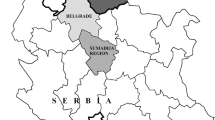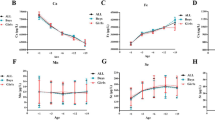Abstract
Of trace elements in the serum of living organisms, selenium (Se) is an essential mineral and plays the role of an antioxidant as selenoproteins protecting the organism against oxidative damage induced by hydrogen peroxide, other lipid hydroperoxides, and their derivatives. The aim of this study was to determine the mean serum Se levels in healthy Korean volunteers (50 males and 50 females) by using an inductively coupled plasma-mass spectrometry method. The samples were collected at the Health Promotion Centre of Kangnam St. Mary’s Hospital, College of Medicine, the Catholic University of Korea, Kangnam District, Seoul in accordance with procedures approved by the Institutional Review Board of the Catholic University of Korea. The mean serum Se level in healthy subjects was 112.05 ± 30.42 μg/l. For gender, it was 120.81 ± 27.37 μg/l for females and 103.29 ± 31.05 μg/l for males. From the study result, there was a significant difference between the mean Se concentrations of gender groups (p = 0.0035). Also, the study indicated no effect of age on Se levels (p > 0.05) in the healthy individuals.

Similar content being viewed by others
References
Savarino L, Granchi D, Ciapetti G, Cenni E, Ravaglia G, Forti P, Maioli F, Mattioli R (2001) Serum concentrations of zinc and selenium in elderly people: results in healthy nonagenarians/centenarians. Exp Gerontol 36:327–329
Clark NA, Teschke K, Rideout K, Copes R (2007) Trace element levels in adults from the west coast of Canada and associations with age, gender, diet, activities, and levels of other trace elements. Chemosphere 70:155–164
Kohrle J, Brigelius-Flohe R, Bock A, Gartner R, Meyer O, Flohe L (2000) Selenium in biology: facts and medical perspectives. Biol Chem 381:849–864
Rotruck JT, Pope AL, Ganther HE, Swanson AB, Hafeman DG, Hoekstra WG (1973) Selenium: biochemical role as a component of glutathione peroxidase. Science 179:588–590
Thomson CD (2004) Assessment of requirements for selenium and adequacy of selenium status: a review. Eur J Clin Nutr 58:391–402
da Cunha S, Filho FMA, Antelo DS, de Souza MM (2003) Serum sample levels of selenium and copper in healthy volunteers living in Rio de Janeiro city. The Science of the Total Environment 301:51–54
Li N, Gao Z, Luo D, Tang X, Chen D, Hu Y (2007) Selenium level in the environment and the population of Zhoukoudian area, Beijing, China. Science of the Total Environment 381:105–111
Kostakopoulos A, Kotsalos A, Alexopoulos J, Sofras F, Deliveliotis Ch, KAllistratos G (1990) Serum selenium levels in healthy adults and its changes in chronic renal failure. International Urology and Nephrology 22:397–401
Korunova V, Skodova Z, Dedina J, Valenta Z, Parizek J, Pisa Z, Styblo M (1993) Serum selenium in adult Czechoslovak population. Biol Trace Elem Res 37:91–99
Dumont E, Vanhaecke F, Cornelis R (2006) Selenium speciation from food source to metabolites: a critical review. Anal Bioanal Chem 385:1304–1323
Klapec T, Mandic ML, Grgic J, Primorac LG, Perl A, Krstanovic V (2004) Selenium in selected foods grown or purchased in eastern Croatia. Food Chem 85:445–452
Sirichakwal PP, Puwastein P, Polngam J, Kongachuichai R (2005) Selenium content of Thai foods. J Food Compos Anal 18:47–59
Ventura MG, Frietas MD, Pacheco A, Van Meerten T, Wolterbeek HT (2007) Selenium content in selected Portuguese foodstuffs. Eur Food Res Technol 224:395–401
Vogt TM, Ziegler RG, Patterson BH, Graubard BI (2007) Racial differences in serum selenium concentration: Analysis of US population data from the Third National Health and Nutrition Examination Survey. Am J Epidemiol 166:280–288
Regina BF (2008) Selenium compounds and selenoproteins in cancer. Chem. Biodiver 5:389–395
Broghamer WL, McConnell KP, Blotcky AL (1976) Relationship between serum selenium levels and patients with carcinoma. Cancer 37:1384–1388
Ringstad J, Jacobsen BK, Tretli S, Thomassen Y (1988) Serum selenium concentration associated with risk of cancer. J Clin Pathol 41:454–457
Dodig S, Cepelak I (2004) The facts and controversies about selenium. Acta Pharm 54:261–276
Navarro-Alarcon M, Cabrera-Vique C (2008) Selenium in food and the human body: A review. Sci Total Environ 400:115–141 doi:10.1016/j.scitotenv.2008.06.024
Kim L, Chung YC, Hwang EJ, Kim J, Lee MK, Park JH, Kim T, Park ST, Soo K (1998) A study on serum concentrations of antioxidant minerals in normal Korean adults. Korean J Nutr 31:324–332
Okhee L, Jongwha M, Yongsam C (2003) Assessment of selenium status in adult females according to life cycle. Korean J Nutr. 36:491–499
Song SH, Song K, Lee SB, Kim CS (2006) The serum selenium level in Korean men and its association with age and prostate cancer. Korean J Urol 47:150–153
Kyung-Hee K, Hyeon-Sook K (2006) Dietary intakes, serum concentrations, and urinary excretions of Fe, Zn, Cu, Mn, Se, Mo, and Cr of Korean young adult women. Korean J Nutr 39:762–772
Labat L, Dehon B, Lhermitte M (2003) Rapid and simple determination of selenium in blood serum by inductively coupled plasma-mass spectrometry (ICP-MS). Anal Bioanal Chem 376:270–273
Oster O, Schmiedel G, Prellwitz W (1998) Correlations of blood selenium which hematological parameters in West Germany adults. Biol Trace Elem Res 15:47–81
Acknowledgement
This study was supported by a grant from the National R&D Program for Cancer Control, Ministry for Health, Welfare and Family affairs, Republic of Korea (070186).
Author information
Authors and Affiliations
Corresponding author
Rights and permissions
About this article
Cite this article
Kim, YJ., Galindev, O., Sei, J.H. et al. Serum Selenium Level in Healthy Koreans. Biol Trace Elem Res 131, 103–109 (2009). https://doi.org/10.1007/s12011-009-8353-6
Received:
Accepted:
Published:
Issue Date:
DOI: https://doi.org/10.1007/s12011-009-8353-6




